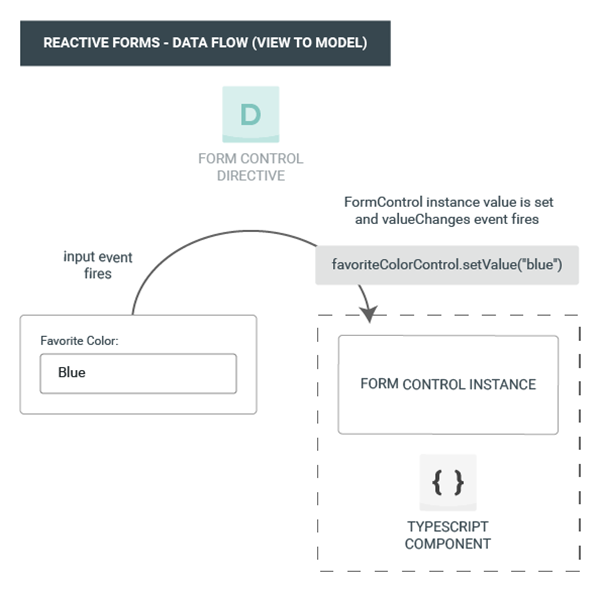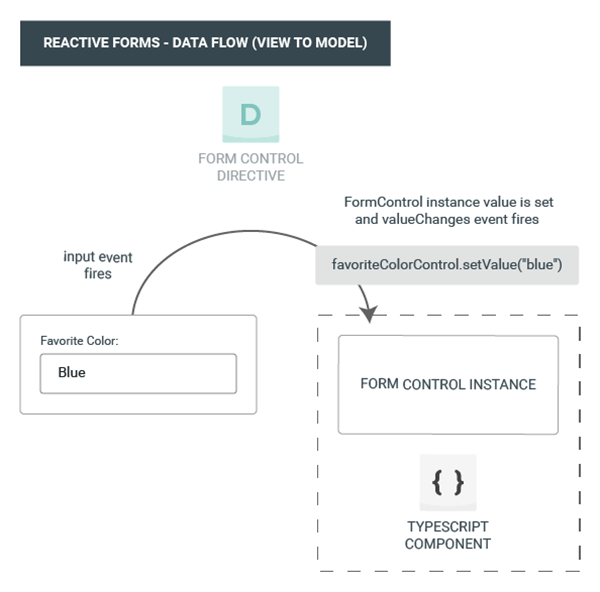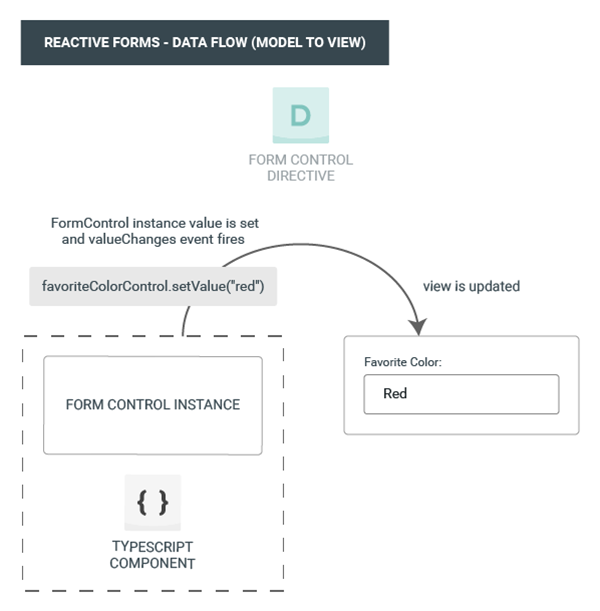What Is The Difference Between Reactive Form And Template Driven Form In Angular
Athwart Forms
The course is the essentials part in any web application. Applications use forms to perform various input driven web operations like logging in, updating the user profile, submitting various kinds of user data through different types of forms like survey, contact, feedback, registration forms etc. All the information-entry tasks are done through forms. On the surface, forms seem straightforward but based on the requirements and data needs, forms tin can be more circuitous and hard to manage. Below are the reasons in support of this argument.
- Class inputs are used to modify data on the page also as the server
- Changes often need to be reflected on the other parts of the page
- The UI needs to conspicuously state expectations and errors, if any
- Dependent fields tin accept complex logic
- Forms are required to be testable, irrespective of DOM selectors usage.
- Users accept a lot of leeway in what they enter, so proper validation of values is essential to make the system consistent.
- Dependent fields tin can accept circuitous logic as their modification touch other fields and their data.
Angular has ii differenet approaches to build and process forms.
- Template Driven Forms
- Reactive Forms
Both capture user input events through the view, validate information technology and create a class/data data model to update. Both approaches uses unlike manner to rail changes in forms.
This guide provides overview of both the approaches and make you determine which approach is better in which scenerio. It introduces the common edifice blocks used by both approaches and summarizes the key differences between the two approaches in the context of setup, information menstruation, validation and testing.
Template Driven Forms
Template-driven forms make use of directives in the template to create and manipulate the underlying object model. This approach is useful when we are setting up a form to get more simpler and small information such every bit a signup, signin form. They're not as scalable as reactive forms. Template-driven forms could be a skillful fit if requirements and logics are much basic. In this approach, whole logic can exist managed solely in the template. All the things happen in Templates hence very lilliputian code is required in the component class. All the behaviors specification and validations are washed using directives and attributes in the template.
Form handling Aspects
- Scalability: Template-driven forms are not as reusable equally they focus on uncomplicated scenarios. They utilize asynchronous information flow between the view and the data model past abstracting away the underlying course API. This brainchild also affects testing so tests are more than reliant on manual change detection execution to run properly, hence require more than setup.
- Setup: Their form model is implicit equally information technology's manage past angular itself. The directive Northward
gModelcreates and manages a Course Control instance for a given grade chemical element. We practise not have direct programmatic admission to the Grade Control example. Here the source of truth is Template. - Testing: Writing tests with template-driven forms requires a proper cognition of the angualr change detection process and an understanding of how directives run on each cycle as to ensure that elements are changed at the correct fourth dimension.
- Validation:Template-driven forms are tied to directives, and must provide custom validator directives to validate forms.
Data Flow
In template-driven forms, each element is linked to a directive that manages the form model internally.
Following steps are performed in information flows when an input field'south value is changed from the view.
- The user types valueinto the input element.
- The input element emits an consequence with that value.
- The control value accessor triggers the
setValue()method on theformControlexample and thenformControlinstance emits the new value. - Subscribers to the
valueChangesobservable receive the new updated value. - The control value accessor too calls the viewModelUpdate() method of NgModelwhich emits a change event.
- Because the component template uses two-way information binding, the property in the component is updated to the value emitted past the
ngModel'due south Changeevent.

Following steps are performed in data flows from model to view when an input field's value is inverse programatically.
- The
propertyvalue is updated in the component itself. - Alter Detection backside and during change detection, the
ngOnChangeslifecycle hook is chosen on the NgModel directive instance as the value of one of its inputs has inverse. - The
ngOnChanges()method pile async chore in a queue to prepare the value for the internalFormControlcase. - Change detection completes.
- On the adjacent tick, set of F
ormControlinstance value is done. -
FormControlinstance emits the provided value through thevalueChangesappreciable. - Any subscribers to the
valueChangesobservable receive the new value. - The control value accessor updates the class input chemical element in the view with the latest value.

Reactive Forms
Reactive forms provide explicit admission to the forms object model. They are more scalable, reusable, and testable and hence robust. Reactive patterns for building your application is highly required if forms are a primal part of your application as they are much more efficient in treatment information for complex forms.
Reactive forms are forms whose structure is divers in the component class i.due east. creation of form model with Form Groups, Form Controls, and Course Arrays is washed in the component course. Validation rules are also defined in the component class. Only binding to the HTML form is washed in the template unlike template-driven approach where we define the logic and controls in the HTML template.
Form handling Aspects
- Scalability: They are more scalable as they provide straight admission to the form API, and use synchronous information flow between the data and the view model, hence help in creating large-scale forms easier. Reactive forms require less setup for testing. Testing does not require deep understanding of athwart change detection to properly test form updates.
- Setup:With reactive forms, we define the form model directly in the component class. The
formControldirective links the explicitly created formControl instance to form elements in the view. Here an internal value accessor is employed. - Testing: They provide a relatively easy testing strategy every bit they provide synchronous access to the data and course models that makes them testable without rendering the UI. In these tests, status and data are manipulated through the control without interacting with the angular change detection cycle.
- Validation: Information technologydefine custom validators as functions that receive a control to validate.
Data Flow
In reactive forms each form element is directly linked to the form model. Updates from the view to the model and from the model to the view are synchronous and exercise not depend on UI rendering.
Following steps are performed in information flows when an input field's value is changed from the view.
- The user types a value into the input chemical element.
- The form input element emits an "input" issue with the provided value.
- The control value accessor on the form input chemical element immediately relays the new value to the formControl instance.
-
FormControlinstance emits the new value usingvalueChangesobservable. - Subscribers to the
valueChangesobservable receive the new value.

Post-obit steps are performed in information flows from model to view when an input field's value is inverse programatically.
- The user calls the controls'due south
setValue()method, which updates the formControl value. -
FormControlexample emits the new value usingvalueChangesobservable. - Subscribers to the
valueChangesobservable receive the new value. - The control value accessor on the grade input element updates the element with the new value.

What Is The Difference Between Reactive Form And Template Driven Form In Angular,
Source: https://www.oodlestechnologies.com/dev-blog/template-driven-vs-reactive-forms/
Posted by: sanchezdeate1964.blogspot.com


0 Response to "What Is The Difference Between Reactive Form And Template Driven Form In Angular"
Post a Comment